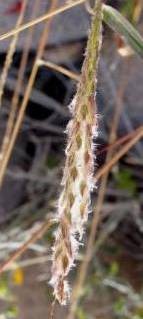Arizona cottontop
(Digitaria californica)

Description
Digitaria californica is a species of grass known by the common name Arizona cottontop. It is native to the Americas, where it can be found in the southwestern United States, Mexico, Central America, and South America. This perennial grass forms a clump of stems reaching up to a meter in height. The branching root system can reach one meter deep. There are no rhizomes or stolons. The leaf sheaths around the stems can be very hairy to woolly. The leaves are usually short and narrow. The inflorescence is a dense, narrow panicle containing pairs of woolly-haired spikelets. This plant grows in a number of habitat types, including desert scrub and shrublands, shrubsteppe, and savanna. In the desert it sometimes grows beneath mesquites where it thrives in the local nutrients. It tolerates varying precipitation amounts and survives easily in drought conditions, becoming dormant at times, then growing quickly when rain returns. Much of its growth occurs in the summer, after the spring and summer rain cycles. Digitaria is a genus of plants in the grass family native to tropical and warm temperate regions but can occur in tropical, subtropical, and cooler temperate regions as well. Common names include crabgrass, finger-grass, and fonio. They are slender monocotyledonous annual and perennial lawn, pasture, and forage plants; some are often considered lawn pests. Digitus is the Latin word for "finger", and they are distinguished by the long, finger-like inflorescences they produce. The prevalent species of Digitaria in North America are large crabgrass (D. sanguinalis), sometimes known as hairy crabgrass; and smooth crabgrass (D. ischaemum). These species often become problem weeds in lawns and gardens, growing especially well in thin lawns that are watered lightly, under-fertilized, and poorly drained. They are annual plants, and one plant is capable of producing 150,000 seeds per season. The seeds germinate in the late spring and early summer and outcompete the domesticated lawn grasses, expanding outward in a circle up to 30 cm (12 in) in diameter. In the autumn when the plants die, they leave large voids in the lawn. The voids then become prime areas for the crabgrass seeds to germinate the following season.
Taxonomic tree:







